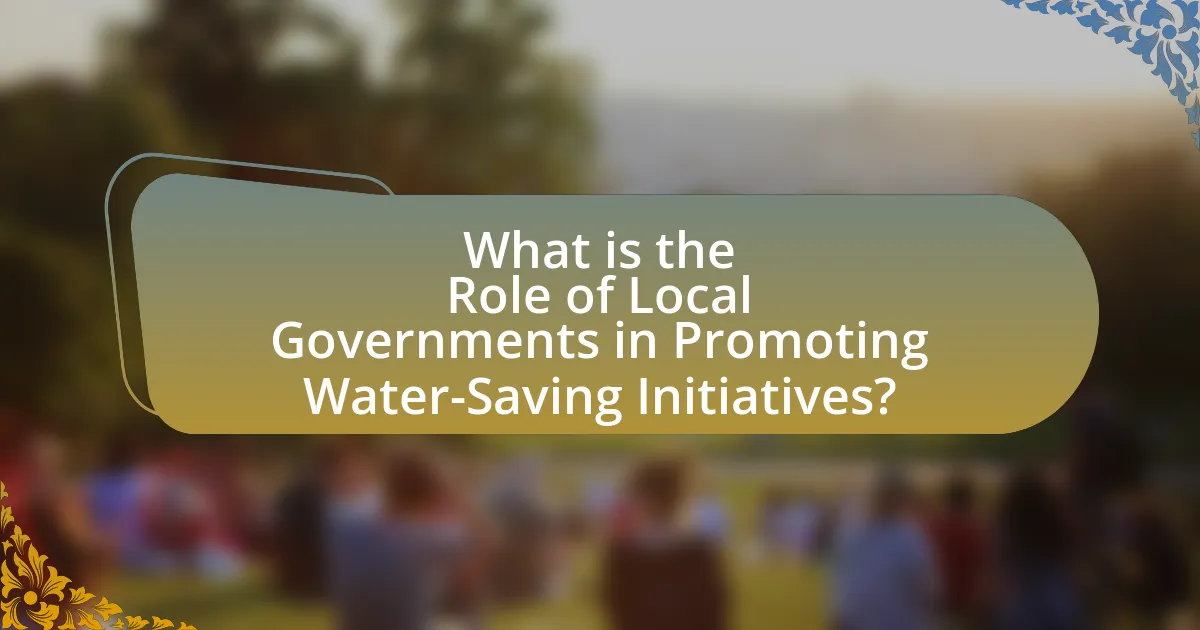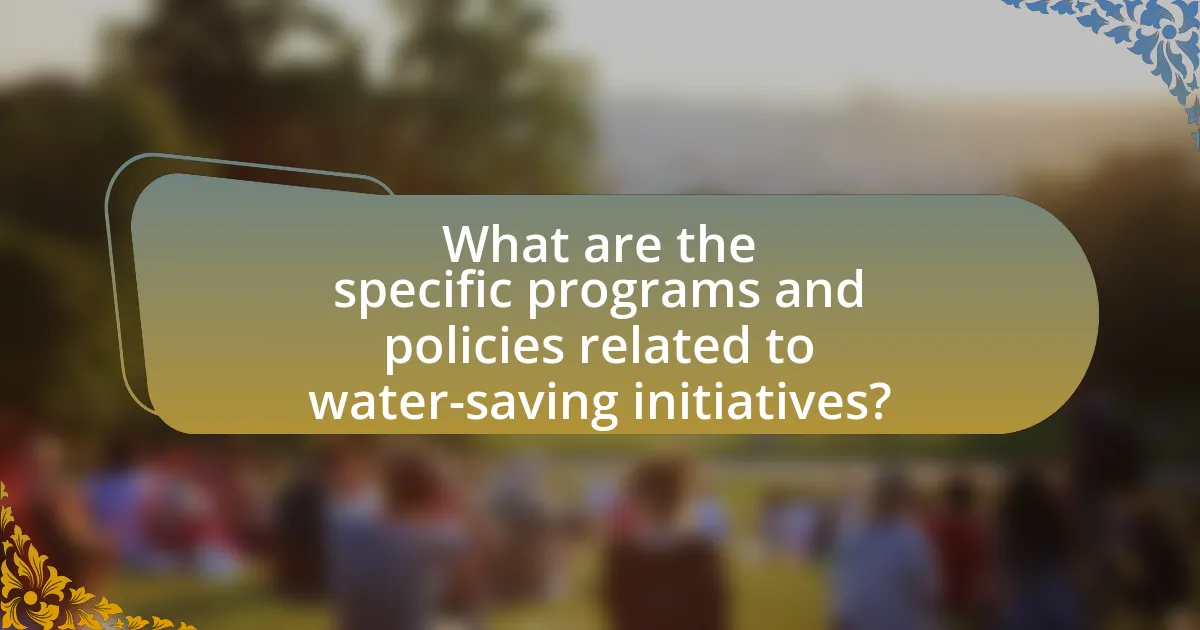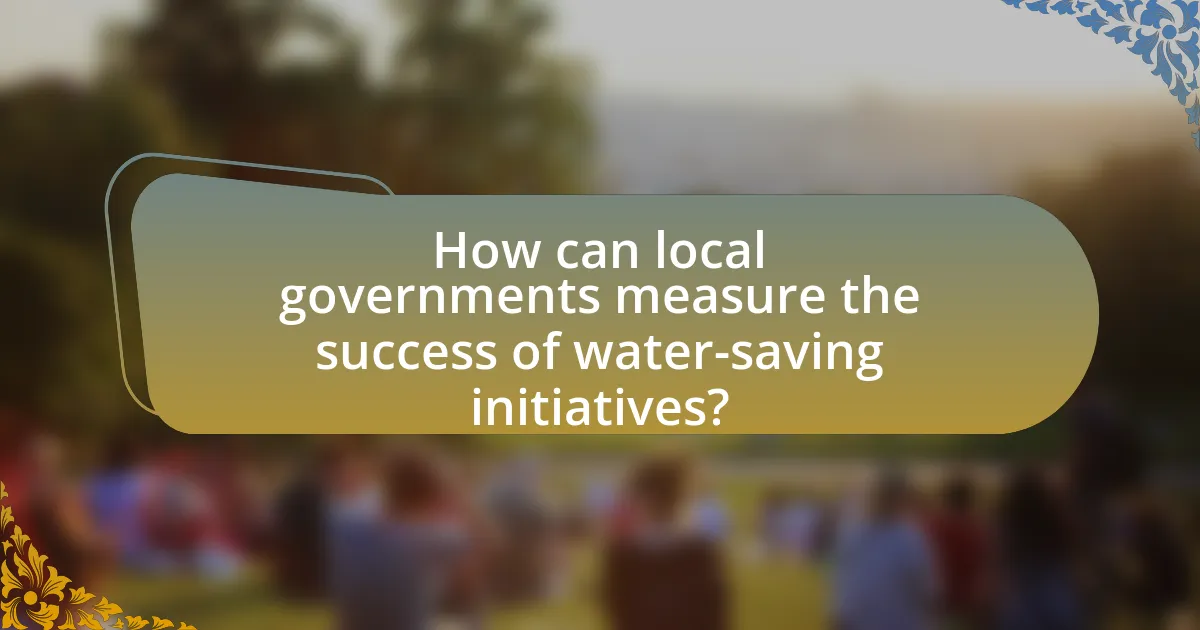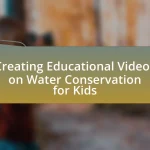Local governments are essential in promoting water-saving initiatives through policy implementation, education, and community engagement. They define these initiatives as programs aimed at reducing water consumption and enhancing sustainable practices, which include regulations, financial incentives, and public awareness campaigns. Key objectives focus on lowering water usage, increasing conservation awareness, and ensuring the sustainability of local water resources. Local governments assess water usage through metering and data analysis, while also collaborating with various entities to enhance the effectiveness of their initiatives. Challenges such as funding limitations and community resistance are addressed through strategic engagement and educational programs, ultimately contributing to improved water management and conservation efforts.

What is the Role of Local Governments in Promoting Water-Saving Initiatives?
Local governments play a crucial role in promoting water-saving initiatives by implementing policies, providing education, and facilitating community engagement. They establish regulations that encourage water conservation practices, such as restrictions on water usage during droughts and incentives for using water-efficient appliances. For example, many local governments offer rebates for residents who install low-flow fixtures or drought-resistant landscaping. Additionally, local governments often conduct public awareness campaigns to educate citizens about the importance of water conservation, which can lead to behavioral changes that significantly reduce water consumption. According to the U.S. Environmental Protection Agency, communities that actively engage in water-saving initiatives can reduce their water use by up to 30%.
How do local governments define water-saving initiatives?
Local governments define water-saving initiatives as programs and policies aimed at reducing water consumption and promoting sustainable water use within their communities. These initiatives often include measures such as implementing water-efficient technologies, promoting public awareness campaigns about water conservation, and incentivizing the use of drought-resistant landscaping. For example, the U.S. Environmental Protection Agency reports that local governments can achieve significant water savings through the adoption of such initiatives, which can lead to reduced utility costs and improved water supply sustainability.
What are the key objectives of these initiatives?
The key objectives of water-saving initiatives promoted by local governments include reducing water consumption, enhancing water conservation awareness among residents, and improving the sustainability of local water resources. These initiatives aim to lower overall water usage through educational programs and incentives, thereby addressing water scarcity issues. For instance, studies have shown that community engagement in water-saving practices can lead to a significant decrease in per capita water use, demonstrating the effectiveness of these initiatives in fostering responsible water management.
How do local governments assess water usage in their communities?
Local governments assess water usage in their communities through a combination of metering, surveys, and data analysis. They install water meters in residential and commercial properties to track consumption accurately, allowing for real-time monitoring of water usage patterns. Additionally, local governments may conduct surveys to gather information on water usage behaviors and preferences among residents. Data analysis of this information helps identify trends, peak usage times, and areas where conservation efforts can be targeted effectively. This systematic approach enables local governments to make informed decisions regarding water management and promote water-saving initiatives tailored to community needs.
Why are water-saving initiatives important for local governments?
Water-saving initiatives are crucial for local governments because they help manage limited water resources effectively and ensure sustainability for future generations. By implementing these initiatives, local governments can reduce water consumption, which is essential in areas facing drought or water scarcity. For instance, the U.S. Environmental Protection Agency reports that water-saving measures can lead to a reduction of up to 30% in residential water use. Additionally, these initiatives can lower operational costs for municipal water systems, enhance community resilience against climate change, and promote public awareness about water conservation.
What environmental impacts do these initiatives address?
Water-saving initiatives primarily address the environmental impacts of water scarcity and ecosystem degradation. These initiatives aim to reduce water consumption, thereby conserving freshwater resources and protecting aquatic habitats. For instance, implementing efficient irrigation systems can decrease water runoff and soil erosion, which are critical for maintaining biodiversity. Additionally, reducing water usage helps mitigate the effects of drought, which has been shown to threaten agricultural productivity and increase competition for water resources among communities.
How do water-saving initiatives contribute to community sustainability?
Water-saving initiatives significantly enhance community sustainability by reducing water consumption and promoting efficient resource management. These initiatives help conserve local water supplies, which is crucial in areas facing water scarcity; for instance, cities that implement rainwater harvesting and greywater recycling can decrease their reliance on external water sources. Additionally, studies show that communities adopting water-efficient practices can lower their utility costs, leading to economic benefits that support local businesses and households. Furthermore, sustainable water management practices contribute to the preservation of local ecosystems, as they help maintain water quality and availability for flora and fauna.
What strategies do local governments employ to promote water-saving initiatives?
Local governments employ various strategies to promote water-saving initiatives, including public education campaigns, financial incentives, and regulatory measures. Public education campaigns raise awareness about the importance of water conservation and provide practical tips for residents to reduce water usage. Financial incentives, such as rebates for water-efficient appliances and landscaping, encourage residents to adopt water-saving technologies. Regulatory measures, like implementing water use restrictions during drought conditions, help manage and reduce overall water consumption. These strategies collectively aim to foster a culture of conservation within communities, ultimately leading to sustainable water management practices.
How do educational programs influence community participation?
Educational programs significantly enhance community participation by increasing awareness and understanding of local issues, such as water conservation. These programs provide residents with the knowledge and skills necessary to engage in sustainable practices, fostering a sense of responsibility towards community resources. For instance, studies have shown that communities with educational initiatives focused on water-saving techniques experience higher participation rates in conservation efforts, as individuals feel more informed and empowered to take action. Research conducted by the American Water Works Association indicates that educational outreach can lead to a 20% increase in community involvement in water-saving programs, demonstrating the direct correlation between education and active participation.
What role do incentives play in encouraging water conservation?
Incentives play a crucial role in encouraging water conservation by providing financial or resource-based motivations for individuals and businesses to reduce water usage. These incentives can include rebates for water-efficient appliances, tiered pricing structures that charge higher rates for excessive use, and grants for implementing water-saving technologies. Research indicates that communities implementing such incentives have seen significant reductions in water consumption; for example, a study by the American Water Works Association found that rebate programs can lead to a 20-30% decrease in residential water use. By aligning economic benefits with conservation efforts, incentives effectively drive behavioral change and promote sustainable water management practices.
How do local governments collaborate with other entities for water-saving initiatives?
Local governments collaborate with other entities for water-saving initiatives through partnerships with non-profit organizations, businesses, and community groups. These collaborations often involve joint programs that promote water conservation practices, such as educational campaigns, incentive programs for water-efficient appliances, and community workshops. For instance, the U.S. Environmental Protection Agency (EPA) has documented numerous successful partnerships where local governments work with organizations like the Nature Conservancy to implement water-saving strategies, resulting in measurable reductions in water usage. Such collaborations leverage resources, expertise, and community engagement to enhance the effectiveness of water-saving initiatives.
What challenges do local governments face in implementing these initiatives?
Local governments face significant challenges in implementing water-saving initiatives, primarily due to limited funding and resources. Budget constraints often hinder the ability to invest in necessary infrastructure and technology for effective water conservation. Additionally, local governments may encounter resistance from the community, as residents might be reluctant to change their water usage habits or support new regulations. Furthermore, a lack of technical expertise can impede the development and execution of innovative water-saving programs. According to a report by the American Water Works Association, 70% of local governments cite funding as a primary barrier to implementing water efficiency measures, highlighting the critical nature of financial support in overcoming these challenges.

What are the specific programs and policies related to water-saving initiatives?
Local governments implement various programs and policies to promote water-saving initiatives, including water conservation ordinances, rebate programs for water-efficient appliances, and public education campaigns. For instance, many municipalities have adopted ordinances that restrict outdoor watering during certain hours or require the use of drought-resistant landscaping. Additionally, rebate programs incentivize residents to replace old fixtures with water-efficient models, often resulting in significant reductions in water usage. Public education campaigns raise awareness about the importance of water conservation and provide practical tips for reducing water consumption at home. These initiatives collectively aim to enhance water sustainability and address water scarcity issues effectively.
How do local governments develop water conservation policies?
Local governments develop water conservation policies through a systematic process that includes assessing local water needs, engaging stakeholders, and implementing regulatory measures. Initially, local governments analyze water usage data and identify areas of concern, such as drought-prone regions or high consumption rates. They then involve community members, businesses, and environmental organizations in discussions to gather input and build consensus on conservation strategies.
Subsequently, local governments draft policies that may include incentives for water-efficient appliances, restrictions on water usage during peak times, and educational programs to raise awareness about conservation practices. For instance, the City of San Diego implemented a water conservation policy that resulted in a 20% reduction in water use over five years, demonstrating the effectiveness of such initiatives.
Finally, these policies are adopted through local legislation and are often monitored and adjusted based on their effectiveness and changing water availability conditions. This structured approach ensures that water conservation policies are tailored to the specific needs and circumstances of the community.
What are the key components of effective water conservation policies?
Effective water conservation policies include regulatory measures, public education, financial incentives, and technological innovation. Regulatory measures establish legal frameworks that limit water usage and promote sustainable practices, such as restrictions on water-intensive landscaping. Public education campaigns raise awareness about the importance of water conservation and provide practical tips for reducing consumption. Financial incentives, such as rebates for water-efficient appliances or tax credits for rainwater harvesting systems, encourage individuals and businesses to adopt water-saving technologies. Technological innovation, including smart irrigation systems and water recycling processes, enhances efficiency and reduces waste. These components collectively contribute to the effectiveness of water conservation policies by promoting responsible water use and ensuring sustainable management of water resources.
How do these policies align with state and federal regulations?
These policies align with state and federal regulations by adhering to established guidelines that promote water conservation and sustainable resource management. Local governments implement water-saving initiatives that comply with the Clean Water Act and state-specific water management laws, ensuring that their practices meet legal standards for environmental protection. For instance, many states have adopted water efficiency standards that local policies must reflect, such as California’s Model Water Efficient Landscape Ordinance, which mandates specific water-saving measures in landscaping. This alignment not only fulfills legal obligations but also supports broader environmental goals set by federal and state authorities, reinforcing the importance of cooperative governance in addressing water scarcity issues.
What community programs are available to support water-saving initiatives?
Community programs that support water-saving initiatives include rebate programs for water-efficient appliances, educational workshops on water conservation, and community gardens that promote sustainable practices. For instance, many local governments offer financial incentives for residents to replace old toilets and washing machines with water-efficient models, which can reduce water usage by up to 50%. Additionally, educational workshops often teach residents about xeriscaping and rainwater harvesting, further encouraging sustainable water use. These programs are designed to engage the community and promote long-term water conservation practices.
How do local governments engage residents in water-saving programs?
Local governments engage residents in water-saving programs through educational campaigns, incentives, and community involvement initiatives. These programs often include workshops, informational materials, and outreach efforts that inform residents about the importance of water conservation and practical methods to reduce water usage. For example, many local governments offer rebates for water-efficient appliances and fixtures, which encourages residents to adopt water-saving technologies. Additionally, community events such as “water conservation days” foster participation and awareness, allowing residents to learn from experts and share best practices. Studies have shown that such engagement strategies can lead to significant reductions in water consumption, demonstrating their effectiveness in promoting sustainable water use.
What resources are provided to assist residents in implementing water-saving practices?
Local governments provide various resources to assist residents in implementing water-saving practices, including educational programs, financial incentives, and access to water-efficient technologies. Educational programs often include workshops and informational materials that teach residents about efficient water use and conservation techniques. Financial incentives may consist of rebates for purchasing water-saving appliances or funding for landscape modifications that reduce water consumption. Additionally, local governments may facilitate access to water-efficient technologies, such as low-flow fixtures and irrigation systems, to encourage residents to adopt sustainable practices. These resources collectively aim to promote water conservation and support residents in reducing their water usage effectively.

How can local governments measure the success of water-saving initiatives?
Local governments can measure the success of water-saving initiatives by analyzing water consumption data before and after the implementation of these programs. This involves tracking changes in water usage patterns through utility billing records, which can reveal reductions in overall water consumption. For example, a study conducted by the American Water Works Association found that communities implementing water conservation programs saw an average reduction in water use by 10-20%. Additionally, local governments can conduct surveys to assess public awareness and participation in water-saving initiatives, further validating the effectiveness of their programs.
What metrics are used to evaluate the effectiveness of these initiatives?
Metrics used to evaluate the effectiveness of water-saving initiatives include water consumption reduction, cost savings, community engagement levels, and environmental impact assessments. Water consumption reduction is measured by comparing baseline usage data before and after the implementation of initiatives, often expressed in gallons or liters saved. Cost savings are calculated by analyzing reductions in water bills and operational costs associated with water supply and treatment. Community engagement levels are assessed through surveys and participation rates in programs, indicating public awareness and involvement. Environmental impact assessments evaluate changes in local ecosystems and water quality, providing a comprehensive view of the initiatives’ effectiveness. These metrics collectively offer a robust framework for assessing the success of local government efforts in promoting water-saving initiatives.
How do local governments track water usage changes over time?
Local governments track water usage changes over time primarily through the implementation of metering systems and data analytics. These systems involve the installation of water meters that record consumption at residential, commercial, and industrial levels, allowing for the collection of detailed usage data. For instance, many municipalities utilize advanced metering infrastructure (AMI) that provides real-time data on water usage patterns, enabling officials to identify trends and anomalies. Additionally, local governments often analyze historical data to assess changes in water consumption over various periods, which can inform policy decisions and water conservation strategies. This approach is supported by studies indicating that accurate metering and data analysis can lead to more effective water management and conservation efforts.
What feedback mechanisms are in place to improve initiatives?
Local governments implement various feedback mechanisms to improve water-saving initiatives, including community surveys, public forums, and performance metrics. Community surveys gather residents’ opinions and suggestions, allowing local governments to assess the effectiveness of their initiatives and make necessary adjustments. Public forums facilitate direct dialogue between officials and citizens, fostering transparency and enabling immediate feedback on water-saving programs. Performance metrics, such as water usage statistics and conservation rates, provide quantifiable data that helps local governments evaluate the success of their initiatives and identify areas for improvement. These mechanisms collectively enhance the responsiveness and effectiveness of water-saving initiatives.
What best practices can local governments adopt for promoting water-saving initiatives?
Local governments can adopt several best practices to promote water-saving initiatives, including implementing educational campaigns, providing incentives for water-efficient appliances, and establishing regulations for water usage. Educational campaigns raise awareness about the importance of water conservation, which can lead to behavioral changes among residents. For instance, studies show that communities with active water conservation education programs can reduce water usage by up to 20%. Providing financial incentives, such as rebates for purchasing low-flow fixtures, encourages residents to invest in water-saving technologies. Additionally, regulations, such as restrictions on lawn watering during drought conditions, can effectively manage water resources. These practices collectively contribute to sustainable water management and conservation efforts.
How can local governments leverage technology for better water management?
Local governments can leverage technology for better water management by implementing smart water systems that utilize sensors and data analytics to monitor water usage and detect leaks in real-time. These systems enable municipalities to optimize water distribution, reduce waste, and enhance conservation efforts. For instance, cities like San Francisco have adopted smart meters that provide detailed consumption data, allowing for targeted outreach and education on water-saving practices. Additionally, the integration of geographic information systems (GIS) helps local governments analyze water resources and plan infrastructure improvements effectively, leading to more sustainable water management strategies.
What role does community engagement play in successful initiatives?
Community engagement is crucial for the success of initiatives, particularly in the context of local governments promoting water-saving measures. Engaging the community fosters a sense of ownership and responsibility, which increases participation and compliance with initiatives. For example, studies have shown that when residents are actively involved in water conservation programs, such as through workshops or local decision-making processes, there is a significant increase in water-saving behaviors. Research by the American Water Works Association indicates that community-driven initiatives can lead to a 20-30% reduction in water usage, demonstrating the effectiveness of engagement in achieving tangible results.
What are some practical tips for residents to support local water-saving initiatives?
Residents can support local water-saving initiatives by implementing simple practices such as fixing leaks, using water-efficient appliances, and reducing outdoor water usage. Fixing leaks in faucets and toilets can save significant amounts of water; for example, a dripping faucet can waste over 3,000 gallons per year. Installing water-efficient appliances, like low-flow showerheads and dual-flush toilets, can reduce water consumption by 20-60%. Additionally, residents can minimize outdoor water usage by watering lawns early in the morning or late in the evening to reduce evaporation, and by using drought-resistant plants in landscaping. These actions collectively contribute to the effectiveness of local water-saving initiatives and help conserve vital water resources.

